Familial amyloidosis pathophysiology: Difference between revisions
Jump to navigation
Jump to search
No edit summary |
No edit summary |
||
| Line 12: | Line 12: | ||
*Amyloid is an abnormal insoluble [[extracellular]] [[protein]] which may cause organic dysfunction and a wide variety of clinical syndromes. | *Amyloid is an abnormal insoluble [[extracellular]] [[protein]] which may cause organic dysfunction and a wide variety of clinical syndromes. | ||
*These abnormal [[Amyloid|amyloids]] are derived from misfolding and aggregation of normally soluble [[Protein|proteins]]. | *These abnormal [[Amyloid|amyloids]] are derived from misfolding and aggregation of normally soluble [[Protein|proteins]]. | ||
*Amyloid depositions also have glycosaminoglycans and serum amyloid P component (SAP) which alter the propensity for amyloid formation.<ref name="pmid8202534">{{cite journal |vauthors=Pepys MB, Rademacher TW, Amatayakul-Chantler S, Williams P, Noble GE, Hutchinson WL, Hawkins PN, Nelson SR, Gallimore JR, Herbert J |title=Human serum amyloid P component is an invariant constituent of amyloid deposits and has a uniquely homogeneous glycostructure |journal=Proc. Natl. Acad. Sci. U.S.A. |volume=91 |issue=12 |pages=5602–6 |date=June 1994 |pmid=8202534 |pmc=44044 |doi=10.1073/pnas.91.12.5602 |url=}}</ref> | *Amyloid depositions also have glycosaminoglycans and serum amyloid P component (SAP) which alter the propensity for amyloid formation.<ref name="pmid8202534">{{cite journal |vauthors=Pepys MB, Rademacher TW, Amatayakul-Chantler S, Williams P, Noble GE, Hutchinson WL, Hawkins PN, Nelson SR, Gallimore JR, Herbert J |title=Human serum amyloid P component is an invariant constituent of amyloid deposits and has a uniquely homogeneous glycostructure |journal=Proc. Natl. Acad. Sci. U.S.A. |volume=91 |issue=12 |pages=5602–6 |date=June 1994 |pmid=8202534 |pmc=44044 |doi=10.1073/pnas.91.12.5602 |url=}}</ref><ref name="pmid7868080">{{cite journal |vauthors=Tan SY, Pepys MB |title=Amyloidosis |journal=Histopathology |volume=25 |issue=5 |pages=403–14 |date=November 1994 |pmid=7868080 |doi=10.1111/j.1365-2559.1994.tb00001.x |url=}}</ref> | ||
*[[Amyloid]] deposition can disrupt tissue structure of involved organ and consequently leads to organ failure.<ref name="pmid267192342">{{cite journal |vauthors=Wechalekar AD, Gillmore JD, Hawkins PN |title=Systemic amyloidosis |journal=Lancet |volume=387 |issue=10038 |pages=2641–2654 |date=June 2016 |pmid=26719234 |doi=10.1016/S0140-6736(15)01274-X |url=}}</ref> | *[[Amyloid]] deposition can disrupt tissue structure of involved organ and consequently leads to organ failure.<ref name="pmid267192342">{{cite journal |vauthors=Wechalekar AD, Gillmore JD, Hawkins PN |title=Systemic amyloidosis |journal=Lancet |volume=387 |issue=10038 |pages=2641–2654 |date=June 2016 |pmid=26719234 |doi=10.1016/S0140-6736(15)01274-X |url=}}</ref> | ||
*Genetic mutations in different genes may lead to misfolding protein product: | *Genetic mutations in different genes may lead to misfolding protein product: | ||
Revision as of 16:02, 7 November 2019
|
Familial amyloidosis Microchapters |
|
Diagnosis |
|---|
|
Treatment |
|
Case Studies |
|
Familial amyloidosis pathophysiology On the Web |
|
American Roentgen Ray Society Images of Familial amyloidosis pathophysiology |
|
Risk calculators and risk factors for Familial amyloidosis pathophysiology |
Editor-In-Chief: C. Michael Gibson, M.S., M.D. [1]; Associate Editor(s)-in-Chief:
Overview
Pathophysiology
Pathogenesis
- It is understood that amyloidosis is the result of deposition of Amyloid.[1]
- Amyloid is an abnormal insoluble extracellular protein which may cause organic dysfunction and a wide variety of clinical syndromes.
- These abnormal amyloids are derived from misfolding and aggregation of normally soluble proteins.
- Amyloid depositions also have glycosaminoglycans and serum amyloid P component (SAP) which alter the propensity for amyloid formation.[2][3]
- Amyloid deposition can disrupt tissue structure of involved organ and consequently leads to organ failure.[4]
- Genetic mutations in different genes may lead to misfolding protein product:
- Transthyretin amyloidosis (ATTR)
- Apolipoprotein AI amyloidosis (A ApoAI)
- Gelsolin amyloidosis (A Gel)
- Lysozyme amyloidosis (A Lys)
- Cystatin C amyloidosis (A Cys)
- Fibrinogen Aa-chain amyloidosis (A Fib)
- Apolipoprotein AII amyloidosis (A ApoAII)
Genetics
- Familial ATTR amyloidosis is transmitted in autosomal dominant pattern but it can have a heterogeneous nature of presentation.[5][6][7]
- Genes involved in the pathogenesis of Familial ATTR amyloidosis include:
Associated Conditions
Conditions associated with amyloidosis include:[8]
- MEN2A
Gross Pathology
On gross pathology, the organs affected by amyloidosis can be characterized by the following features:
- Porcelain like or waxy appearance
- Enlargement
Images
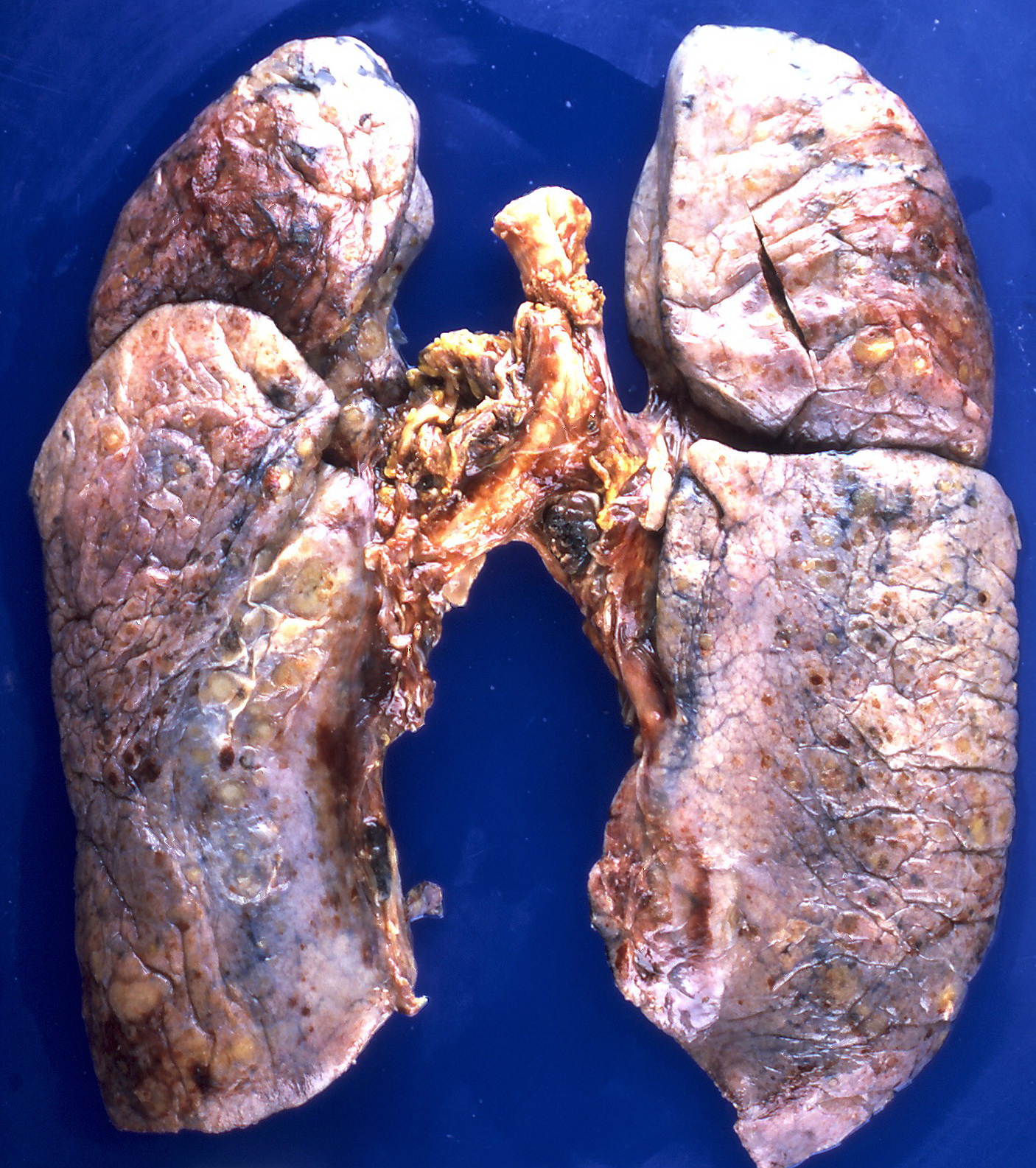
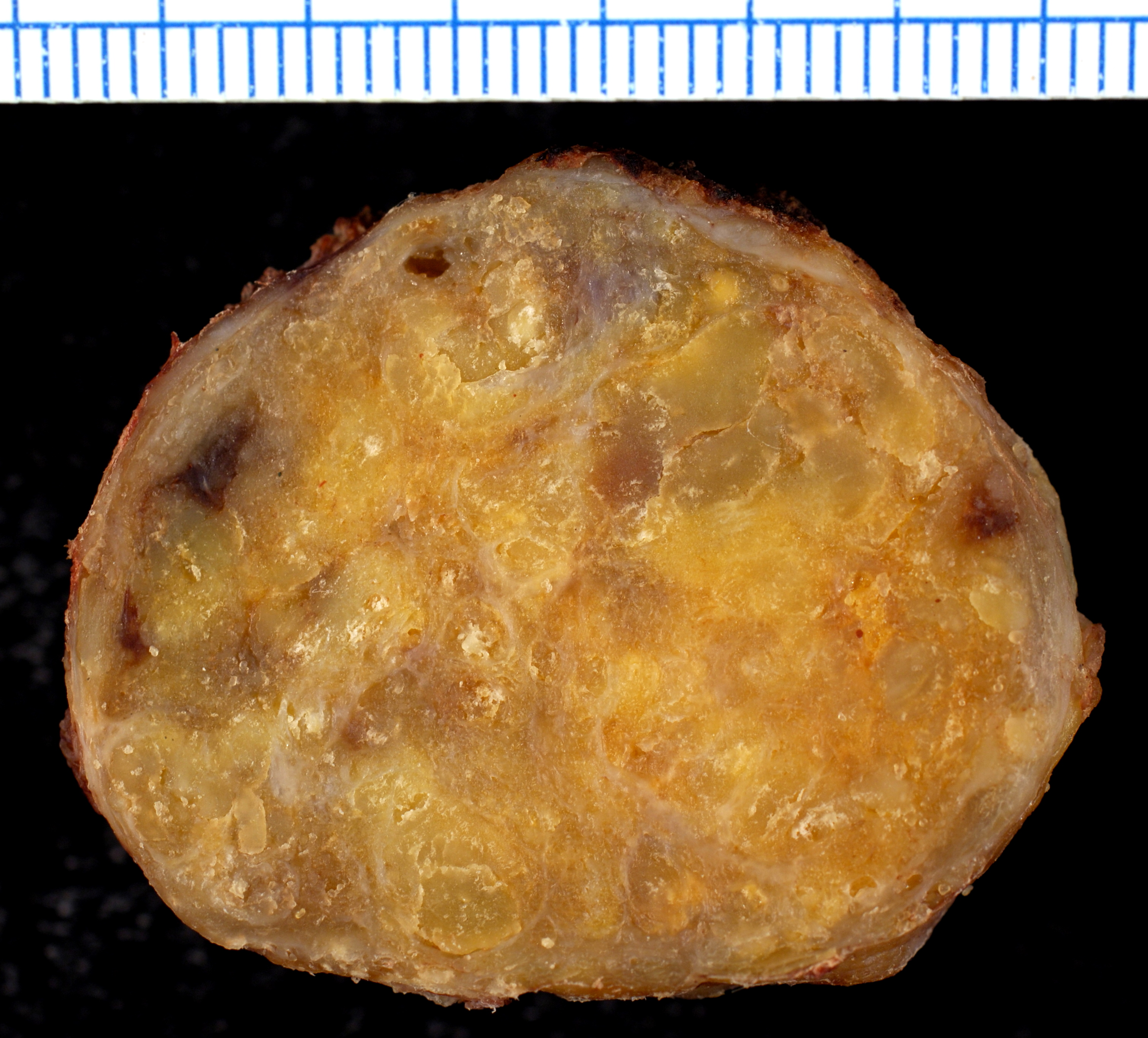
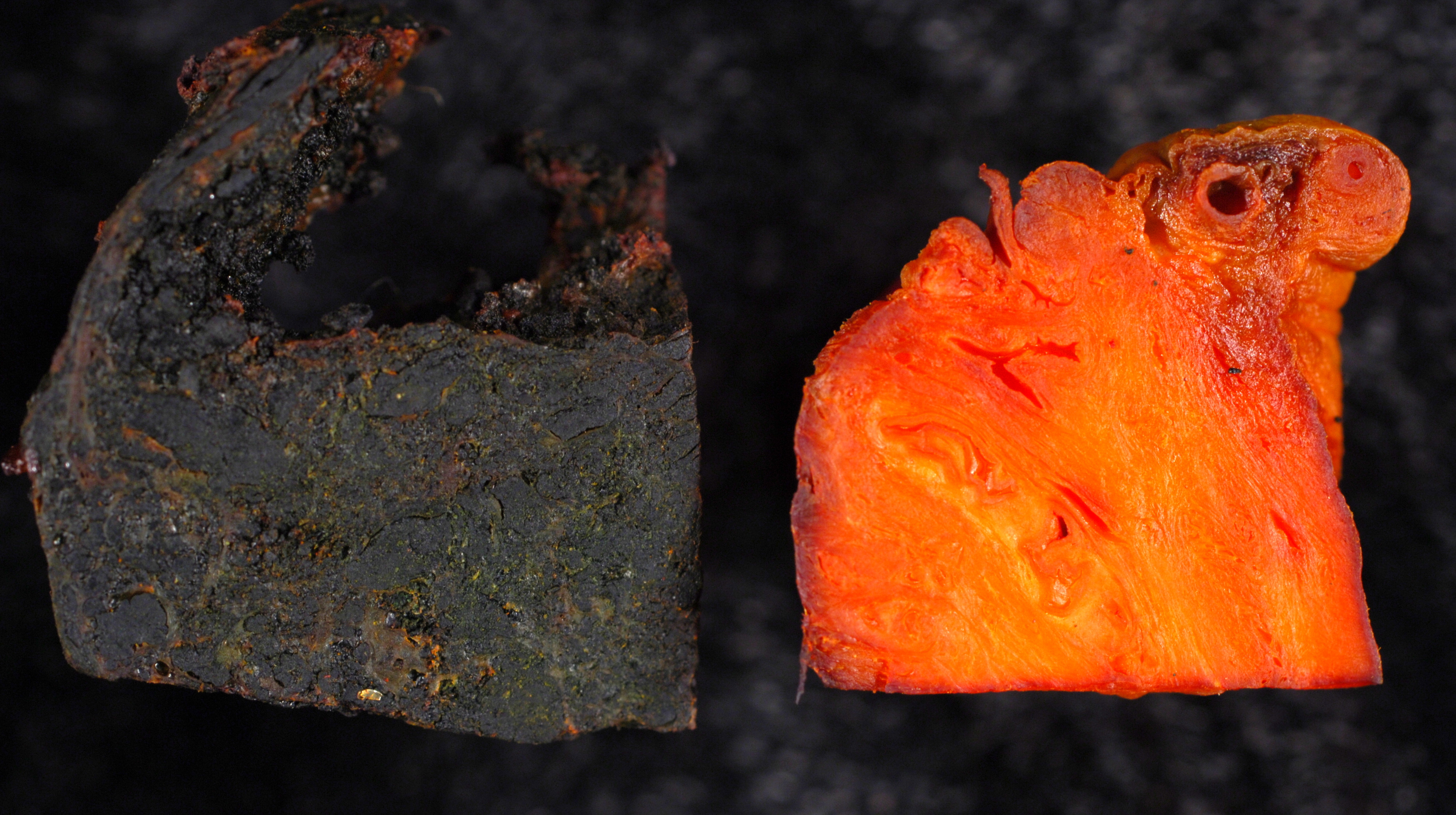
Microscopic Pathology
On microscopic histopathological analysis, amyloidosis is characterized by:[7][12]
- Green birefringence under polarized light after Congo red staining (appears red under normal light)
- Linear non-branching fibrils (indefinite length with an approximately same diameter)
- Distinct X-ray diffraction pattern consistent with Pauling's model of a cross-beta fibril
Images
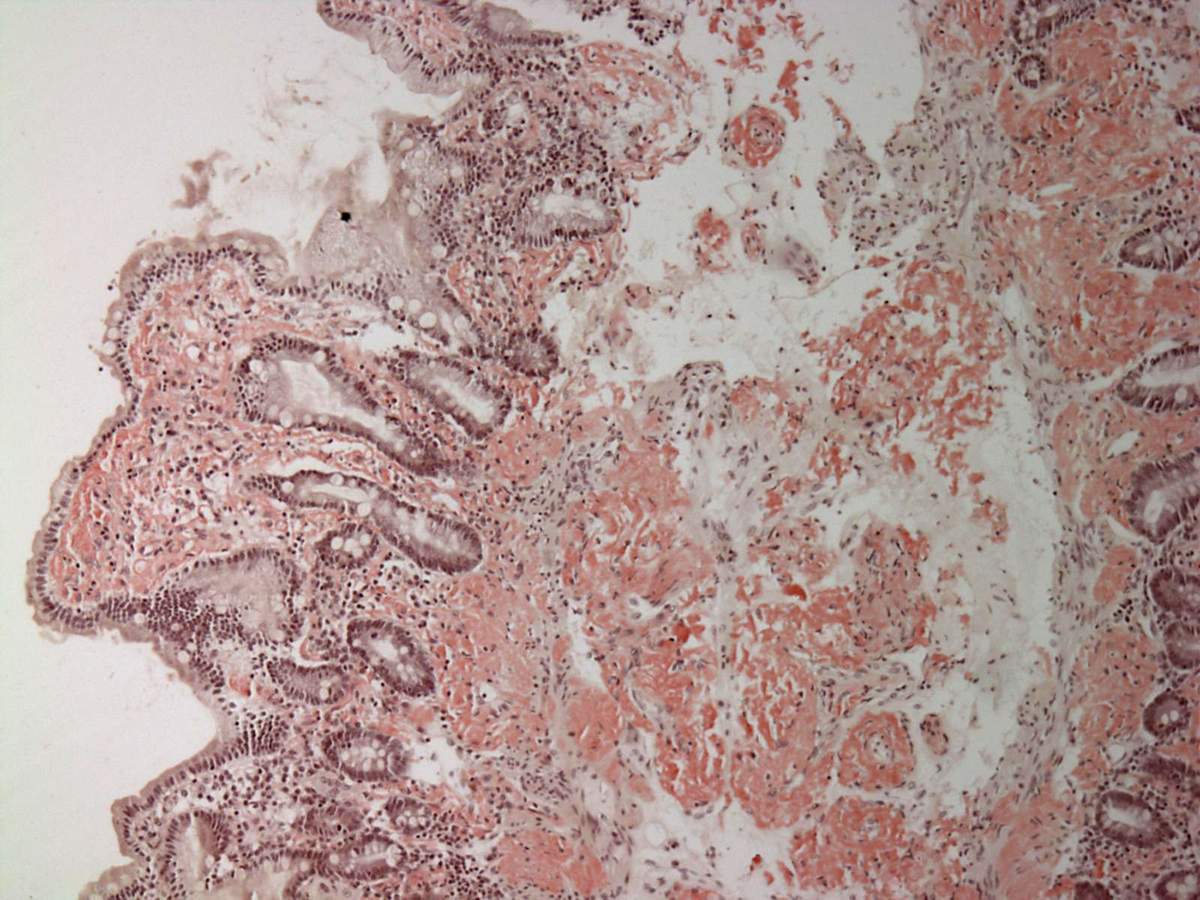
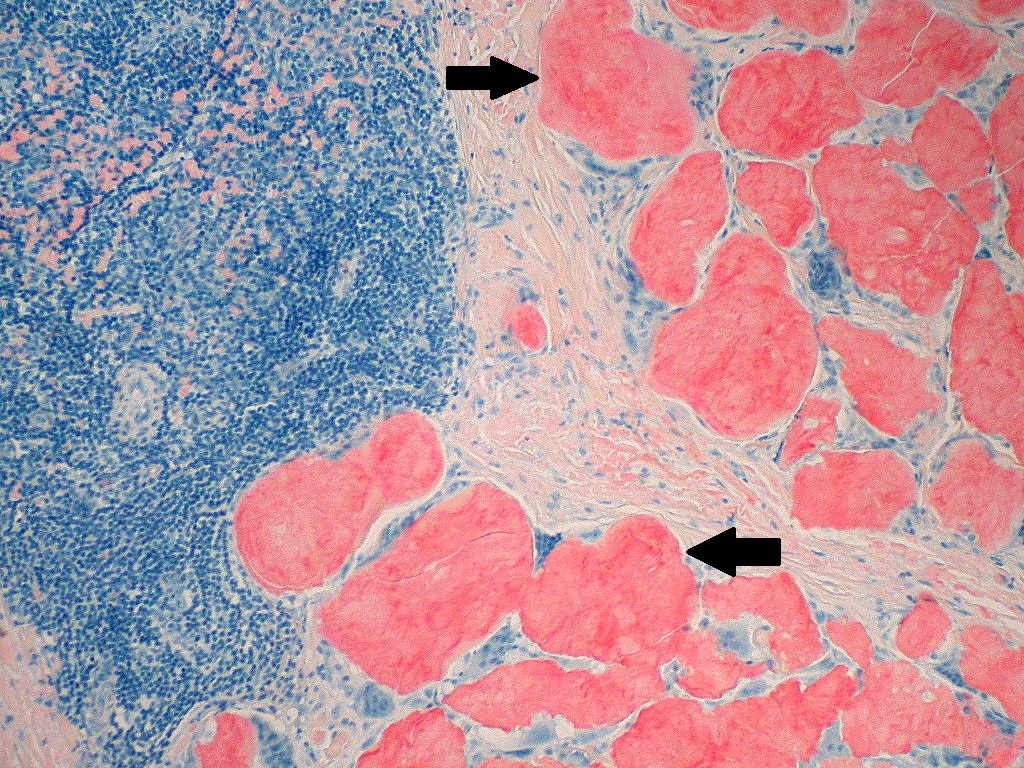
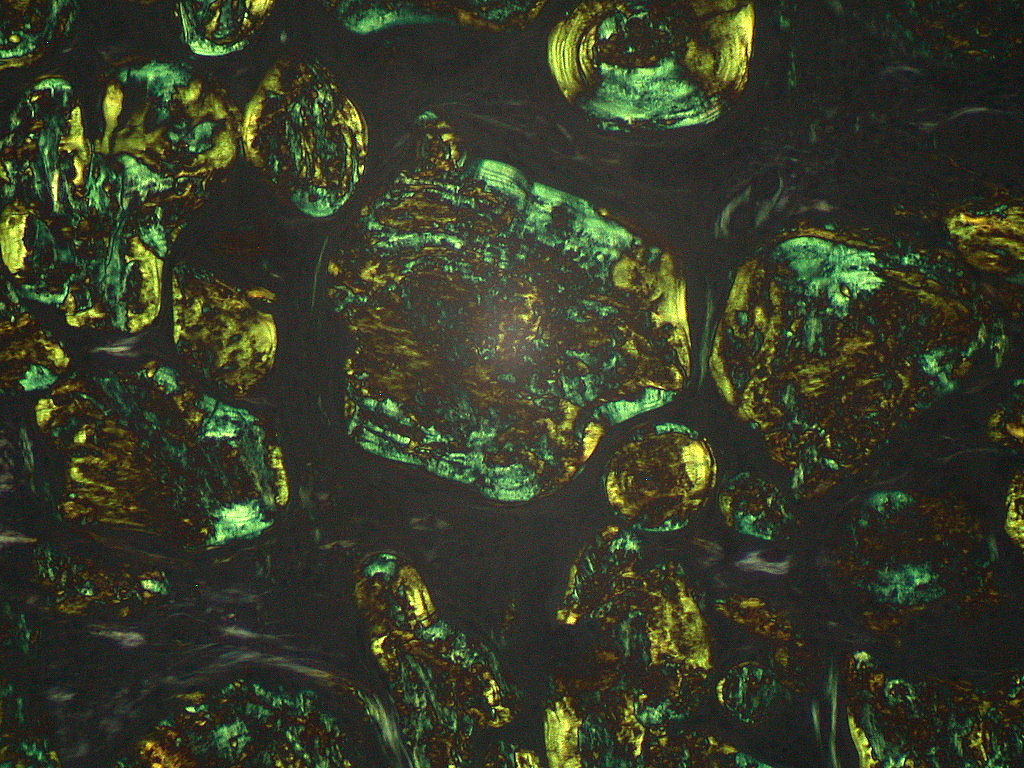
References
- ↑ Wechalekar AD, Gillmore JD, Hawkins PN (June 2016). "Systemic amyloidosis". Lancet. 387 (10038): 2641–2654. doi:10.1016/S0140-6736(15)01274-X. PMID 26719234.
- ↑ Pepys MB, Rademacher TW, Amatayakul-Chantler S, Williams P, Noble GE, Hutchinson WL, Hawkins PN, Nelson SR, Gallimore JR, Herbert J (June 1994). "Human serum amyloid P component is an invariant constituent of amyloid deposits and has a uniquely homogeneous glycostructure". Proc. Natl. Acad. Sci. U.S.A. 91 (12): 5602–6. doi:10.1073/pnas.91.12.5602. PMC 44044. PMID 8202534.
- ↑ Tan SY, Pepys MB (November 1994). "Amyloidosis". Histopathology. 25 (5): 403–14. doi:10.1111/j.1365-2559.1994.tb00001.x. PMID 7868080.
- ↑ Wechalekar AD, Gillmore JD, Hawkins PN (June 2016). "Systemic amyloidosis". Lancet. 387 (10038): 2641–2654. doi:10.1016/S0140-6736(15)01274-X. PMID 26719234.
- ↑ Hund E, Linke RP, Willig F, Grau A (February 2001). "Transthyretin-associated neuropathic amyloidosis. Pathogenesis and treatment". Neurology. 56 (4): 431–5. doi:10.1212/wnl.56.4.431. PMID 11261421.
- ↑ Gertz MA (June 2017). "Hereditary ATTR amyloidosis: burden of illness and diagnostic challenges". Am J Manag Care. 23 (7 Suppl): S107–S112. PMID 28978215.
- ↑ 7.0 7.1
- ↑ Hofstra RM, Sijmons RH, Stelwagen T, Stulp RP, Kousseff BG, Lips CJ, Steijlen PM, Van Voorst Vader PC, Buys CH (August 1996). "RET mutation screening in familial cutaneous lichen amyloidosis and in skin amyloidosis associated with multiple endocrine neoplasia". J. Invest. Dermatol. 107 (2): 215–8. doi:10.1111/1523-1747.ep12329651. PMID 8757765.
- ↑ By Yale Rosen from USA - Amyloidosis, CC BY-SA 2.0, https://commons.wikimedia.org/w/index.php?curid=31127928
- ↑ By Ed Uthman, MD - https://www.flickr.com/photos/euthman/377537238/, CC BY-SA 2.0, https://commons.wikimedia.org/w/index.php?curid=1629764
- ↑ By Ed Uthman, MD - https://www.flickr.com/photos/euthman/377538012/, CC BY-SA 2.0, https://commons.wikimedia.org/w/index.php?curid=1629740
- ↑ Röcken C, Shakespeare A (February 2002). "Pathology, diagnosis and pathogenesis of AA amyloidosis". Virchows Arch. 440 (2): 111–122. doi:10.1007/s00428-001-0582-9. PMID 11964039.
- ↑ By Michael Feldman, MD, PhDUniversity of Pennsylvania School of Medicine - http://www.healcentral.org/healapp/showMetadata?metadataId=38717, CC BY 2.0, https://commons.wikimedia.org/w/index.php?curid=870218
- ↑ By Ed Uthman, MD - https://www.flickr.com/photos/euthman/377559787/, CC BY-SA 2.0, https://commons.wikimedia.org/w/index.php?curid=1629716
- ↑ By Ed Uthman, MD - https://www.flickr.com/photos/euthman/377559955/, CC BY-SA 2.0, https://commons.wikimedia.org/w/index.php?curid=1629705